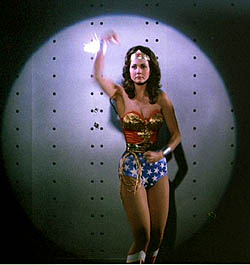Pre-Crisis
In the Golden Age of Comics, the Amazons of Paradise Island are depicted wearing the bracelets as a symbol of submission to their patron goddess Aphrodite and, under the goddess's instruction, as a reminder to the Amazons of the folly of submitting to men and the resultant period when they were subjugated under the rule of the treacherous Hercules. The bracelets are magically made to be indestructible by Aphrodite, and are used as magically indestructible bracers which can deflect bullets, energy weapons, and any murderous weapons in Man's World.
The bracelets were originally said to be made of bronze, but in Wonder Woman #52, published in March 1952, it is first mentioned that the bracelets are composed of Amazonium, an indestructible fictional metal.
In Sensation Comics #4, it is revealed that Amazons temporarily lose their superhuman strength if a male welds chains to their bracelets together. Their strength remains unaffected if they are chained by females (Sensation Comics #10). They regain their strength if their bracelets are unchained. In later stories, Amazons lose their strength if males simply bind their wrists, rather than their bracelets, with chains or other forms of welding. In Comic Cavalcade #14, the bracelets are revealed to balance Amazon strength with loving submission to the positive aims of civilization.
The consequences of removing bracelets become simplified in later stories: if ever broken or removed, the Amazon would go into an uncontrollable destructive frenzy, as Dr. Marston's allegory for the unfettered destruction by the human ego. The bracelets are rarely broken, they can be broken only by magical weapons empowered by the gods themselves (such as Artemis's sword and Aegeus's dagger of Vulcan).
Post-Crisis
The Amazons are, as before, charged with wearing their bracelets as a constant reminder of their experience of enslavement. They also wear the bracelets as a penance of failing their mission to reform mankind. However, they do not lose their strength if males chain their bracelets together, and are not cursed with madness should the bracelets be removed or broken. Additionally, the generic Amazon bracelet provides no special protection.
When Diana wins the Contest to become Wonder Woman, she is given a pair of magical silver bracelets. The bracelets are later explained as having been forged from the remnants of the Aegis, a shield made from the indestructible hide of the great she-goat, Amalthea, who suckled Zeus as an infant. When crossed before her, the bracelets are able to generate a remnant of the Aegis, allowing Diana to deflect attacks far larger than the surface area of her bracelets. This remnant takes the form of a semi-visible spherical forcefield roughly twice the height of Diana.
Both Donna Troy and Cassie Sandsmark also have their own indestructible silver bracelets. When Hippolyta operates as Wonder Woman after Diana's resurrection, she likewise wears her own silver bracelets. When John Byrne took over the writing and art duties, he depicted the bracelets as larger than usual and bracer-like, with extension pieces being semi-distinct from the original bracelets.
It was revealed during Gail Simone's tenure as the title's writer that Zeus endowed the bracelets with the power to channel his divine lightning when they are struck together at will. [11]
It was revealed in the New 52 that Wonder Woman's bracelets help her control her divine powers as a daughter of Zeus, as shown when she removes them during a fight with Artemis. [12]
